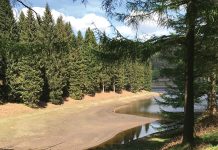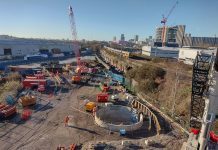The Munchengladbach Waste Water Treatment Plant treats a population equivalent of 850,000. The facility, which has a tight phosphate discharge consent, includes an Anaerobic Digestion (AD) plant which is located a considerable distance from the onsite sludge centre.
In 2005 significant problems with crystal deposit formations were encountered in the pipeline between the digesters and the sludge centre as well as associated valves and equipment including the centrifuge drums. The crystal deposits were identified as Magnesium – Ammonium – Phosphate (MAP), with the chemical formula NH4MgPO4•6H2O, also known as Struvite. MAP is normally produced in a high pH, high conductivity and temperature environment where magnesium, aluminium and phosphate are present in a 1:1:1 mole ratio. Therefore, WWTP’s with AD and low P consents are particularly prone to MAP formation. The presence of MAP at Munchengladbach WWTP caused considerable operational issues for the plant including, but not limited to: –
• Reduction in sludge treatment capacity
• Problems operating valves
• Significant vibration issues with the centrifuges
• Considerable wear of plant and equipment
Significant maintenance time and costs were incurred in trying to minimise the effects of the MAP deposits including physical removal with a hammer and chisel as well as intensive acid cleaning. This was not a sustainable long term solution.
A MAP inhibitor was then dosed into the system which proved effective at prevention but operational costs were high.
In September 2005, a pilot trial commenced using the Struvex process, which is based on a patent owned by Berlin Water. This process consists of a large vessel with an internal reactor section into which air and magnesium chloride (MgCl2) are dosed to raise the pH value to 8.1. The digested sludge is fed into the tank where the process causes the MAP crystals to form and then precipitate, whilst reducing the phosphate load in the sludge from 450 mg/L down to 40 mg/L. The pilot plant treated 25 m3/h and was located in an existing concrete storage tank into which EPDM diffusers were installed and fed by a rotary piston compressor. Magnesium chloride was dosed from a 40 m3 double walled storage tank. The original Struvex trial ran up until May 2006 and was then extended pending installation of the full facility. The trial proved very successful in eliminating MAP formation and encrustation of plant and equipment.
During the pilot trial, there was a 2.3% point improvement in dewatering of the sludge which was a considerable additional operational and financial benefit to the client.
Annual sludge operation and disposal costs for the Bio-P plant on its own were running at EUR 3.15m, with the addition of the dosed MAP inhibitor costs rose to EUR 3.2m. Annual costs for the Bio-P plant with the Struvex MAP precipitation plant are EUR 2.6m providing an annual saving of EUR 600K.
Following the successful trial and the additional economic benefits a full scale Struvex plant has now been installed at the facility. Due to lack of space the system had to be split into a two reactor process located in the sludge centre, with a total of 7-8 hours’ retention time in the Struvex reactors. The process diagram is detailed in Fig 6.
The MAP (Struvite) is separated out and cleaned in a grit washer before being fed into a waste skip. The daily struvite output at Munchengladbach from the Struvex process ranges between 1 and 1.5 tonnes per day. The Struvite is removed from site by lorry and sold as a fertilizer.
CSO Technik are the exclusive UK suppliers/installers of the Struvex process in the UK and Republic of Ireland for P.C.S – Pollution Control Service GmbH. For further information please contact Thom Gornall or Colin Froud or visit www.csotechnik.com.







